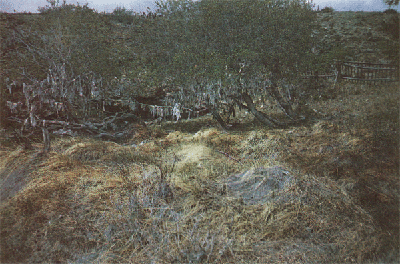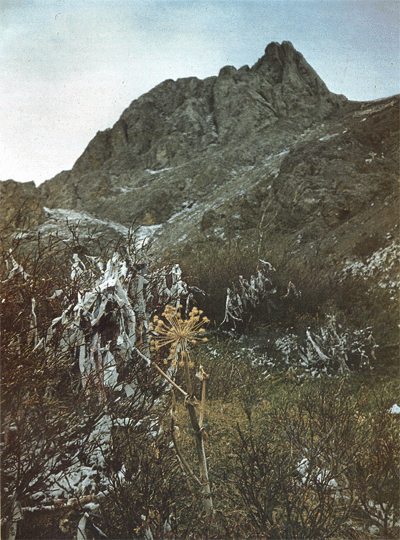



|

|

|
In the eastern part of the republic bordering on Mongolia deep in the taiga near the confluence of three mountain rivers there are many hot springs (up to 80° C). These springs are called "arjaan Ush-Beldir" (after the name of the place) or "North arjaan". According to geologists, these springs are connected with the fracture in the earth's crust. These nitric thermal waters contain dissolved hydrogen sulfide and one can smell it from a far distance. The aijaan water also contains silicic acid in concentration effective in medicinal treatment. There is a health resort "Ush-Beldir" on the basis of this spring.

Somewhat further to the south in the same earth's crust there is the area called "Tarys" (after the name of the river) with another hot spring - "arjaan Tarys" ("South arjaan"). The chemical composition and the balneological properties of this arjaan are similar to arjaan Ush-Beldir, but its temperature is a little lower - only 47° C. Arjaans Ush-Beldir and Tarys are analogues of hot springs of Baikal region, Gagry and Sernovodsk (the Caucasus), Saihan-Hulgy (Mongolia).
Hydrogene sulfide and nitric and silicic acid hot springs like arjaans Ush-Beldir and Tarys are recommended for diseases of the blood circulation, (throvibophlebitis), disorder of tfie movement function (arthritis), bone and muscle system, chronical diseases of the peripheral nervous system (radiculitis, neuritis), urological, gynecological and skin diseases, illness of endocrine system and some maladies connected with metabolism. The fame of those hot springs has spread far beyond the Republic of Tuva.
Another famous arjaan is situated in the far northwest region of the republic which is very picturesque but difficult to reach. It borders on Buryatia and is called Ezyg-Sug ("Hot water"). It lies in the canyon at the confluence of two roaring mountain rivers. This arjaan is called Choygan which means "Silver fir". And indeed the spring is surrounded by beautiful virgin silver fir forest which fills the ravine with delicate healing anticeptic fragrance. Arjaan Choygan is an unique complex of thermal and hot carbonic waters where carbon dioxide is either in dissolved or spontaneous state.
For businessman's attention. Deep juvenile waters are the result of magmatic processes. They contain carbon dioxide of magmatic origin, so this spring is a good remedy for aging people (in Latin "juvenus" means "youth"). According to Russian researcher A.Kostenko (Thejournal "Chemistry and Life", 1991, N 11), the use of these waters results in increasing the acidity of inner ferment balance (including blood) which eliminates the so called "mineral of death" - hydroxylapatite the excess quantity of which in blood vessels affects their elasticity and transparency, leads to atherosclerosis and in the long run to early aging. Isn't it why people living in Toji (the region where aijaan is situated) regularly drink the water and they look young and live long. It could be a good idea to start bottling Choygan waters and to be always young. It's an eveiybody's dream!
The chemical composition of these waters is hydrocarbon, soda lime. The hot spring (the temperature reachers 41-43° C) also contains silicic acid in balneo-logically reasonable quantities. These waters are effective in curing a wide range of diseases: heart and vascular system, nervous system, digestion, gastritis, colitis, diseases of liver and biliary ducts, chronical pancreatitis, metabolism, respiratory tract (excluding tuberculosis). Aijaan Choygan has analogues - mineral waters of Molokovo, Borjomy, Pyatigorsk (CIS). Among foreign analogues one can mention mineral waters of Karlovy Vaiy (Czech and Slovak Republic). A Russian topographer Kryjyn who visited Toji in 1858 proved that waters of aijaan Choygan are similar to famous seltzer waters (Natural sources Oberselters Niederzselters, Germany).
The therapeutic effect of the Choygan spring is enhanced by Alpine microclimatic characteristics. (The absolute mark is 1550 meters above sea). Since aijaan is situated in the ravine, green grass and flowers grow in the area of this hot spring even in cold winter. Fir trees and rapid mountain rivers are also considered as a prophilactic factor of medical importance. Besides there is a variety of herbs in the vicinity of aijaan. Therefore the balneotherapy can be supplemented by the climate therapy and phytotherapy. The future of this unique complex of thermal and cold carbonic waters - Choygan mineral springs - is in upgrading their sanatoriums and tourist centers to the world standard.

In the western part of Tuva there are many radon springs. The most popular ones are the arjaans "Shevelig", "Dostug-Hem", "Dorgun" and "Ulaatie". The waters of aijaan Shevelig and Dorgun are ultra fresh and the waters of Dustug-Hem ("Salt River") and Ulaatie are mineral (sodium chloride and sulphate-hydrocarbonic). Waters containing radon are prescribed for the treatment of perepheral nervous system, heart diseases, disorders of motor functions. The scope of the use of radon mineral waters is wider and they are especially good in case of disorders of digestion. Before, taking in the radon water should be settled for 10-15 minutes to eliminate radon. Radon is a radioactive gas and its over-dosage may cause unpleasant complications. Local people use radon arjaans to cure respirative disorders and skin diseases.
Arjaan Shevelig is a low radon spring - radon concentration is 360 eman or 1350 Bk/1. Macrochemical composition is hydrocarbonic, magnesium-sulphate-calcium. It also contains silicic acid and organic carbon in the quantities close to the balneological standards. The anticeptic properties of the water are attributed to silicic acid, and it also contains organic carbon advisable in case of urological diseases. (Famous mineral water brand "Naftusia"). Arjaan Shevelig has analogues: waters of Leapovka, Hapunvar, Keasegatch.
Nowadays there is a preventorium (a health after work maintenance) using waters of this spring. In the mid 80-es the local authorities introduced charges for using waters of the arjaan in order to finance to utilities improvement.
Arjaan Ulaatie is also a low radon spring (100-150 eman or 300-400 Bk/1). In contrast to Shevelig spring arjaan Ulaatie is a low mineralized spring (2g/l) so its waters can be used for inner consumption. Its macro-chemical composition (sulphate-hydrocarbonic-magne-sium) has no analogues in the springs of the CIS countries. Because of the specific effect of main ions of magnesium and calcium on the human organism the waters of Ulaatie arjaan are good for medical treatment of disorders of digestion and liver illnesses. People say that the arjaan waters help to cure Botkin's disease and different eczemas. But surely this statement requires clinical tests.
In the centre of Tuva (region Chaa-Hol) on the left bank of the Yenisei river down to the confluence of its large tributary - the Hemchik river - there is a small stream in the ravine of the bushy hills. This acid spring is a very famous and sacred Tuvian arjaan "Ajig-Sug" ("Acid Water"). It attracts people suffering from gastritis and stomach ulcer. People are coming to this spring to drink the water almost all year round. In winter there is a thick 1 meter ice crust and people crush big lumps of "salt ice". The arjaan Ajig-Sug (other local names are Ir-Sailykh and Uur-Sair) is. well known not only in the Tuva Republic. Before the collapse of the USSR people from the central part of the country, from the Baltic republics and the Ukraine were frequent visitors here. And they found remedy not only for gastritis, digestion disorders but skin diseases as well.
Here are some facts about the composition of this arjaan. This is an acid spring (pH 3,6) of low mineralization (approximately 4 g/1). Macrochemical composition: sulphate-magnesium-calcium. It contains silicic acid in large quantities (over 100 mg/1) and ions of iron (up to 30 mg/1). Which allows to call it ferrous and siliceous spring as well. In contrast to many other mineral springs the arjaan Ajig-Sug due to its acid composition contains a large spectrum of microelements: aluminium, copper, zinc, manganese, strontium, litium and other. The best analogues are waters "Kysliy" (Krasnodar) and "Kuegda" (Sakhalin).
The balneological effect of the aijaan Ajig-Sug is attributed to its salt-ion composition, ions of iron, silicic acid and other microelements. Such mineral waters are recommended for treatment of gastritis, colitis, pancreatitis, chronical diseases of liver, biliary and urinal ducts, stomach ulcer, duodenum, diabetes, inflammation process, hypoferric anemia.
Nowadays the aijaan Ajig-Sug is the only well known and thorougly researched acid mineral spring in Tuva. Judging by its balneological effect it is really a national treasure.
|
Author: Kara-Kys Donghak Arakchaa
tyvakyzy@umail.ru
Veb design: Taybyl Chingis tci@ngs.ru |